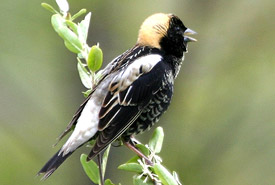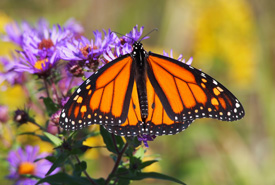Staley Point

Bobolink (Photo by Bill Hubick)
A key piece of Wolfe Island coastline protected
At the eastern end of Lake Ontario, like a stopper at the top of the St. Lawrence River, Wolfe Island is simultaneously the most easterly of the Great Lakes islands and also the largest island in the Thousand Islands archipelago. Wolfe Island is a place of biological, historical and cultural significance. Serving as a stopover for waterfowl and other migratory birds, it provides wintering grounds for snowy owl, gyrfalcon, rough-legged hawk and other northern raptors. The island is a vibrant agricultural community and is a favourite destination for birders and photographers.
Located at the extreme northwestern corner of Wolfe Island, just six kilometres south of Kingston, Staley Point has a vibrant cultural history. Its Indigenous history stretches back to time immemorial. For thousands of years, the island was used as a permanent and semi-permanent settlement by Indigenous communities, including Huron-Wendat, Haudenosaunee, Mississauga and Algonquin-speaking Peoples. Later, Staley Point was part of the seigneury (estate of a French noble) of French explorer and trader René-Robert Cavelier La Salle, which was awarded to him in 1675 by King Louis XIV of France. In 1685, the property was part of the very first private land sale in Upper Canada when La Salle transferred the island to Jacques Cauchois.
In the last century, Staley Point became a local hunt club. In the late 90s, the club’s membership was dwindling and interest in keeping the lands protected waned. However, club member Bill Brown stepped forward to purchase the property to protect it from future development. In 2004, Brown deeded the land to his three daughters, who continued to keep it as a wild retreat as a tribute to their father.
In addition to its distinguished cultural history, Staley Point is critical to local nature conservation. Large marsh wetlands on the south side of the property filter the water flowing off Wolfe Island into Lake Ontario, while providing habitat for an impressive suite of waterfowl. Its expansive grasslands are home to large numbers of migratory, at-risk birds, such as bobolink and eastern meadowlark, and provide habitat for the endangered monarch along its epic migration route.
Eastern Lake Ontario coast — a priority for conservation

Monarch (Photo by NCC)
NCC is actively working to help conserve priority lands around the Lake Ontario coast, stretching from Brighton and Presqu’ile Provincial Park to just west of Gananoque, and south to include Prince Edward County and coastal islands. This scenic and historic landscape contains a rich mosaic of coastal wetlands, forests, streams, sand beaches and dunes, islands and alvars. It includes world-class coastline and provides critical habitat for grassland and migratory birds. The area is home to a multitude of plant and animal species, many of which are provincially, nationally and globally rare.
Quick facts
- Location: Wolfe Island, six kilometres south of Kingston
- Habitat type: meadow, wetland, shoreline
- Size: 33 hectares (82 acres)
- Species: bobolink, eastern meadowlark and monarch




